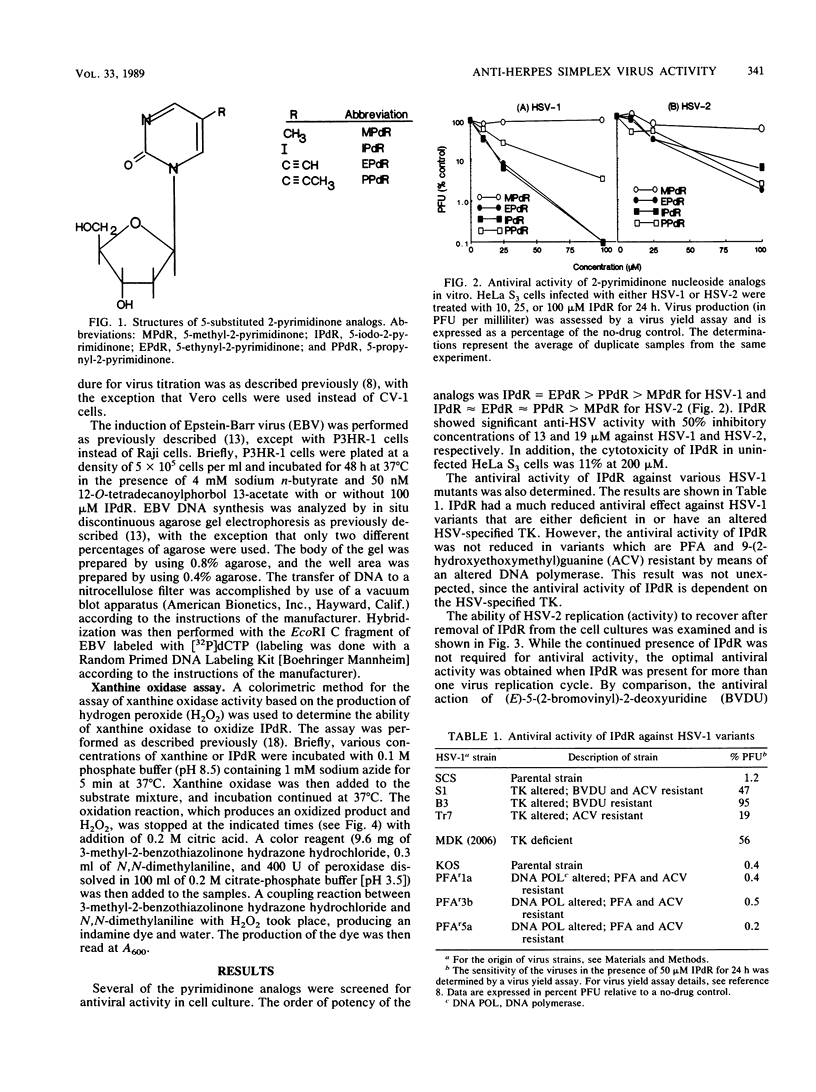Abstract
Several 5-substituted 2-pyrimidinone 2'-deoxyribonucleoside (PdR) analogs were examined for their anti-herpes simplex virus (HSV) activity in cell culture. The order of potency of their antiviral activities against HSV type 1 (HSV-1) and HSV-2 was iodo PdR approximately ethynyl PdR approximately propynyl PdR. The antiviral action of iodo PdR is dependent on the ability of HSV to induce virus-specified thymidine kinase in infected cells. Several HSV-1 variants with altered thymidine kinase changed their sensitivity to iodo PdR, whereas HSV-1 variants with altered DNA polymerase were as sensitive as the parental virus to iodo PdR. Continuous presence of iodo PdR for more than one virus replication cycle was required for optimal antiviral activity. Iodo PdR (100 microM) had no activity against Epstein-Barr virus DNA replication in P3HR-1 cells. With an oral, an intraperitoneal, or a subcutaneous route of injection, iodo PdR administered twice a day for 2.5 days could prevent the death of mice infected with HSV-2. This in vivo activity is unlikely to be related to the potential conversion of iodo PdR to iododeoxyuridine, since iodo PdR is not a substrate of xanthine oxidase.
Full text
PDF




Selected References
These references are in PubMed. This may not be the complete list of references from this article.
- Allaudeen H. S., Chen M. S., Lee J. J., De Clercq E., Prusoff W. H. Incorporation of E-5-(2-halovinyl)-2'-deoxyuridines into deoxyribonucleic acids of herpes simplex virus type 1-infected cells. J Biol Chem. 1982 Jan 25;257(2):603–606. [PubMed] [Google Scholar]
- Bastow K. F., Derse D. D., Cheng Y. C. Susceptibility of phosphonoformic acid-resistant herpes simplex virus variants to arabinosylnucleosides and aphidicolin. Antimicrob Agents Chemother. 1983 Jun;23(6):914–917. doi: 10.1128/aac.23.6.914. [DOI] [PMC free article] [PubMed] [Google Scholar]
- Booth V. H. The xanthine oxidase-aldehyde system. Biochem J. 1938 Mar;32(3):503–507. doi: 10.1042/bj0320503. [DOI] [PMC free article] [PubMed] [Google Scholar]
- Cheng Y. C. A rational approach to the development of antiviral chemotherapy: alternative substrates of herpes simplex virus Type 1 (HSV-1) and Type 2 (HSV-2) thymidine kinase (TK). Ann N Y Acad Sci. 1977 Mar 4;284:594–598. doi: 10.1111/j.1749-6632.1977.tb21992.x. [DOI] [PubMed] [Google Scholar]
- Cheng Y. C., Dutschman G., Fox J. J., Watanabe K. A., Machida H. Differential activity of potential antiviral nucleoside analogs on herpes simplex virus-induced and human cellular thymidine kinases. Antimicrob Agents Chemother. 1981 Sep;20(3):420–423. doi: 10.1128/aac.20.3.420. [DOI] [PMC free article] [PubMed] [Google Scholar]
- Cheng Y. C., Grill S., Ruth J., Bergstrom D. E. Anti-herpes simplex virus and anti-human cell growth activity of E-5-propenyl-2'-deoxyuridine and the concept of selective protection in antivirus chemotherapy. Antimicrob Agents Chemother. 1980 Dec;18(6):957–961. doi: 10.1128/aac.18.6.957. [DOI] [PMC free article] [PubMed] [Google Scholar]
- Efange S. M., Alessi E. M., Shih H. C., Cheng Y. C., Bardos T. J. Synthesis and biological activities of 2-pyrimidinone nucleosides. 2. 5-Halo-2-pyrimidinone 2'-deoxyribonucleosides. J Med Chem. 1985 Jul;28(7):904–910. doi: 10.1021/jm00145a010. [DOI] [PubMed] [Google Scholar]
- Frank K. B., Chiou J. F., Cheng Y. C. Interaction of DNA polymerase and nucleotide analog triphosphates. Adv Enzyme Regul. 1985;24:377–384. doi: 10.1016/0065-2571(85)90087-1. [DOI] [PubMed] [Google Scholar]
- KIT S., DUBBS D. R. Acquisition of thymidine kinase activity by herpes simplex-infected mouse fibroblast cells. Biochem Biophys Res Commun. 1963 Apr 2;11:55–59. doi: 10.1016/0006-291x(63)90027-5. [DOI] [PubMed] [Google Scholar]
- Larder B. A., Derse D., Cheng Y. C., Darby G. Properties of purified enzymes induced by pathogenic drug-resistant mutants of herpes simplex virus. Evidence for virus variants expressing normal DNA polymerase and altered thymidine kinase. J Biol Chem. 1983 Feb 10;258(3):2027–2033. [PubMed] [Google Scholar]
- Mancini W. R., De Clercq E., Prusoff W. H. The relationship between incorporation of E-5-(2-Bromovinyl)-2'-deoxyuridine into herpes simplex virus type 1 DNA with virus infectivity and DNA integrity. J Biol Chem. 1983 Jan 25;258(2):792–795. [PubMed] [Google Scholar]
- Nutter L. M., Grill S. P., Li J. S., Tan R. S., Cheng Y. C. Induction of virus enzymes by phorbol esters and n-butyrate in Epstein-Barr virus genome-carrying Raji cells. Cancer Res. 1987 Aug 15;47(16):4407–4412. [PubMed] [Google Scholar]
- RAJAGOPALAN K. V., HANDLER P. HEPATIC ALDEHYDE OXIDASE. 3. THE SUBSTRATE-BINDING SITE. J Biol Chem. 1964 Jun;239:2027–2035. [PubMed] [Google Scholar]
- Smee D. F., Martin J. C., Verheyden J. P., Matthews T. R. Anti-herpesvirus activity of the acyclic nucleoside 9-(1,3-dihydroxy-2-propoxymethyl)guanine. Antimicrob Agents Chemother. 1983 May;23(5):676–682. doi: 10.1128/aac.23.5.676. [DOI] [PMC free article] [PubMed] [Google Scholar]
- Sugiura M., Kato K., Adachi T., Ito Y., Hirano K. A new method for the assay of xanthine oxidase activity. Chem Pharm Bull (Tokyo) 1981 Feb;29(2):430–432. doi: 10.1248/cpb.29.430. [DOI] [PubMed] [Google Scholar]


